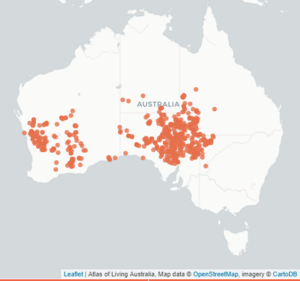Sturts pigface facts for kids
Quick facts for kids Sturts pigface |
|
|---|---|
| Scientific classification | |
| Genus: |
Gunniopsis
|
| Species: |
quadrifida
|
The Gunniopsis quadrifida, also known as the Sturts pigface, is a special plant found only in Australia. It belongs to the Aizoaceae family, which is full of different types of plants that can live in very dry or salty places. These plants have unique leaves that help them survive in tough environments. Like many plants in this family, the Sturts pigface is a succulent. This means it has thick, fleshy leaves that store water, helping it get through dry spells. It grows as a small shrub.
Contents
What Does the Sturts Pigface Look Like?
The Sturts pigface is a succulent plant from the iceplant family, Aizoaceae. It is native to Australia.
This shrub usually grows into a compact, rounded shape. It can reach a height of about 0.2 to 1 meter (which is about 0.6 to 3.3 feet). Its leaves are quite long, around 8 centimeters (about 3 inches).
When it flowers, the Sturts pigface produces white blooms. These flowers are about 4 centimeters (1.6 inches) wide. In the western parts of Australia where it grows, you can see it flowering from August to January. In southern areas, it might flower all year round. After flowering, it produces black, kidney-shaped seeds that are very small, only up to 1.5 millimeters long.
Where Does the Sturts Pigface Live?
You can find the Sturts pigface around salt lakes and on salty, flat areas in the inland parts of Western Australia. This includes regions like the Wheatbelt, Mid West, and Goldfields-Esperance. It grows well in sandy, loamy, or clay soils.
It also lives in inland areas of the Northern Territory, South Australia, Queensland, and New South Wales. This plant likes to grow near the edges of salt lakes and clay pans.
While it's found across many areas, the Sturts pigface is considered "near threatened" in the Northern Territory, Queensland, and New South Wales because it's rarely seen there. It's much more common in the northern parts of South Australia and Western Australia.
How is the Sturts Pigface Related to Other Plants?
The Sturts pigface was first described by a botanist named Ferdinand von Mueller in 1859. He first called it Sesuvium quadrifidum. Later, in 1861, he changed its name to Aizoon quadrifidum. Finally, in 1889, another botanist named Ferdinand Albin Pax moved it to the Gunniopsis group of plants.
Closely Related Species There are 14 different species in the Gunniopsis group. These plants used to be in other groups like Aizoon, Gunnia, and Neogunnia. All these species look similar because they have evolved to live in dry and salty places. The name Gunniopsis means "resembling Gunnia," which shows its similarity to the Gunnia plant group.
Some of the other species in the Gunniopsis group include:
- Gunniopsis divisa
- Gunniopsis glabra
- Gunniopsis intermedia
- Gunniopsis kochii
- Gunniopsis papillata
- Gunniopsis propinqua
- Gunniopsis rodwayi
- Gunniopsis rubra
- Gunniopsis septifraga
- Gunniopsis tenuifolia
- Gunniopsis zygophylloides
- Gunniopsis calcarea Chinnock
- Gunniopsis calva
Out of all these, the Gunniopsis quadrifida (Sturts pigface) is the most common and widespread species.
Why is the Sturts Pigface Important to Protect?
As the human population grows, we use more land for homes and farms. This can cause problems like breaking up natural habitats, introducing new species that don't belong, and climate change. These issues can harm ecosystems and threaten plants and animals.
The Sturts pigface population has already shrunk in inland New South Wales, the Northern Territory, and Queensland. This decline can happen because of human activities. For example, illegal harvesting (taking plants without permission) or, more likely, damage to their habitat from increased land use. These actions have reduced the number of plant species compared to how many there were before European settlement.
Even though most population growth in Australia is in big cities, new technologies might lead to more development in dry areas. This could threaten the desert landscapes where the Sturts pigface currently lives, away from much human activity.
Many desert animals rely on the Sturts pigface for food and shelter. If the plant's life cycle changes due to climate change (which is called a shift in phenology), it could affect these animals. That's why it's important to study and monitor the Sturts pigface. This helps protect the animals that depend on it and watch out for any new species that might compete with it, which could put the Sturts pigface at risk.


